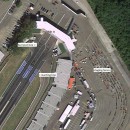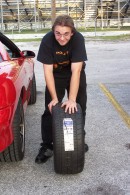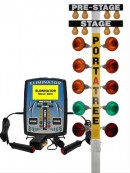At first glance, racing in a straight line seems simple. However, there are hundreds of variables to consider as your car approaches the lights. Because there is ample opportunity for embarrassment and calamity, come along for a brief introduction to a very addictive experience.
With over two decades of amateur racing, I would like to breakdown (not literally) the methods and procedures needed to run your first few passes. Let’s begin with your daily driver. First, read every post in last month’s #tuning month, then read them again. Now its time for a comprehensive fluid flush. Coolant, oil, transmission fluid, and your differentials need to have the good stuff for optimal performance.
While they are draining, take a rubber hammer to everything. Loose nuts can ruin your day, so a paint pencil and a torque wrench should be used to make sure everything stays tight. If your brake rotors are warped or your tires have seen better days, forget about it. Now is a perfect time to remove all unnecessary weight. Start by making sure your fuel level is low. Then you need to leave all non-essentials at home. Headrests, floormats, the spare tire and jack are all fair game.
Once you are at the track, you will need a tech card. This critical information will be used by the tower to pick your opponent and to offer color commentary by the announcer, so don’t embellish too much. If you are running on street tires, try to find the slowest looking car in the staging area and inform the owner this is your first time. It’s a great way to make friends because everyone is in the same boat. Don’t forget to drop your tire pressures for optimal grip, and tune your radio to the track’s FM station. The goal of your first passes will be to learn how to launch. This is a power play between your tires and the engine, with both feet involved.
Unless you have drag-radials, go around the burnout box (your street tires don’t like smoking). On top of the Christmas tree are four lights. These correspond to two starting lines separated by a 7” gap. PRO TIP: stage with the front tires if you don’t want to be ridiculed. Here you can choose how far back you would like to start. Once both cars are staged, a computer begins the countdown. Three amber lights each have a half-second delay before the green, so try to leave on the 2nd one at first.
The goal here is to not jump the gun. If you do, a red light will bathe you in shame for your trip to the top end. Launching is such a dark art because it easily finds the weakest part of your drivetrain. If something breaks, don’t move. Otherwise, you risk putting parts and fluids in the path of the cars coming behind you.
Take it easy on your first few runs so you can learn the shutdown area. Everyone likes to think they have the best brakes in the world, but you need to know every aspect of the top end in case something goes wrong. The timing shack will hand you a slip with tons of data. Most important among them is your 60’. How quickly your car covers the first 60 feet is the critical measure of your car’s consistency, and the foundation for going faster.
Therefore, you need to practice launching as often as possible. You will either bog the car down or spin the tires, so there’s no need to race to the end. Go easy to gain confidence. When I started in 2001, my 60’ time was 2.1 seconds, an eternity. After two decades of learning, anything slower than 1.6 will have me singing the blues. Learning to launch properly is so daunting that racing from a rolling start has become popular for a few amateur classes. Invest in a spare set of wheels with sticky rubber before your next outing if you want to enjoy the next lesson in our #Celebration Month 21.
Your goal is to transfer as much weight as possible onto the rear tires. The problem with many late-model cars is that they simply overpower the stock suspension. At stock power levels, the 7” differential in a 4th generation Camaro has a tendency to explode, while cars with independent rear suspension erupt into wheel hop. Once these issues are resolved, you will have a consistent way to have fun with like-minded enthusiasts. Competing against yourself is much more addictive than drugs or booze, so don’t say we didn’t warn you!
While they are draining, take a rubber hammer to everything. Loose nuts can ruin your day, so a paint pencil and a torque wrench should be used to make sure everything stays tight. If your brake rotors are warped or your tires have seen better days, forget about it. Now is a perfect time to remove all unnecessary weight. Start by making sure your fuel level is low. Then you need to leave all non-essentials at home. Headrests, floormats, the spare tire and jack are all fair game.
Unless you have drag-radials, go around the burnout box (your street tires don’t like smoking). On top of the Christmas tree are four lights. These correspond to two starting lines separated by a 7” gap. PRO TIP: stage with the front tires if you don’t want to be ridiculed. Here you can choose how far back you would like to start. Once both cars are staged, a computer begins the countdown. Three amber lights each have a half-second delay before the green, so try to leave on the 2nd one at first.
The goal here is to not jump the gun. If you do, a red light will bathe you in shame for your trip to the top end. Launching is such a dark art because it easily finds the weakest part of your drivetrain. If something breaks, don’t move. Otherwise, you risk putting parts and fluids in the path of the cars coming behind you.
Therefore, you need to practice launching as often as possible. You will either bog the car down or spin the tires, so there’s no need to race to the end. Go easy to gain confidence. When I started in 2001, my 60’ time was 2.1 seconds, an eternity. After two decades of learning, anything slower than 1.6 will have me singing the blues. Learning to launch properly is so daunting that racing from a rolling start has become popular for a few amateur classes. Invest in a spare set of wheels with sticky rubber before your next outing if you want to enjoy the next lesson in our #Celebration Month 21.
Your goal is to transfer as much weight as possible onto the rear tires. The problem with many late-model cars is that they simply overpower the stock suspension. At stock power levels, the 7” differential in a 4th generation Camaro has a tendency to explode, while cars with independent rear suspension erupt into wheel hop. Once these issues are resolved, you will have a consistent way to have fun with like-minded enthusiasts. Competing against yourself is much more addictive than drugs or booze, so don’t say we didn’t warn you!








